Autumn 2017-2018: E-Commerce Impact on Small Enterprises Report
VerifiedAdded on 2020/04/21
|10
|3678
|89
Report
AI Summary
This report delves into the impact of e-commerce on small enterprises within developing countries. It begins by highlighting the importance of e-commerce for these businesses, emphasizing its potential to drive economic growth and provide competitive advantages. The report then explores the various impacts of e-commerce, including financial benefits such as reduced costs and increased revenue, and socioeconomic benefits like improved market access and enhanced quality of life. Furthermore, it discusses procurement benefits, such as cost savings and improved inventory management, and productivity gains stemming from streamlined processes and enhanced information access. The study also acknowledges challenges such as the slow adoption of e-commerce in developing countries and the need for proper ICT planning. Overall, the report underscores the transformative potential of e-commerce for small enterprises in developing countries, while also acknowledging the need to address barriers to its adoption.

The impact of E-Commerce
Student’s full name:
Student’s programme:MSc in Financial Management
Module:Acamedic Skills
Academic Year / Semester:2017-2018 Autumn
Word Count1:
Seminar leader:
Due Date:
1
Student’s full name:
Student’s programme:MSc in Financial Management
Module:Acamedic Skills
Academic Year / Semester:2017-2018 Autumn
Word Count1:
Seminar leader:
Due Date:
1
Secure Best Marks with AI Grader
Need help grading? Try our AI Grader for instant feedback on your assignments.
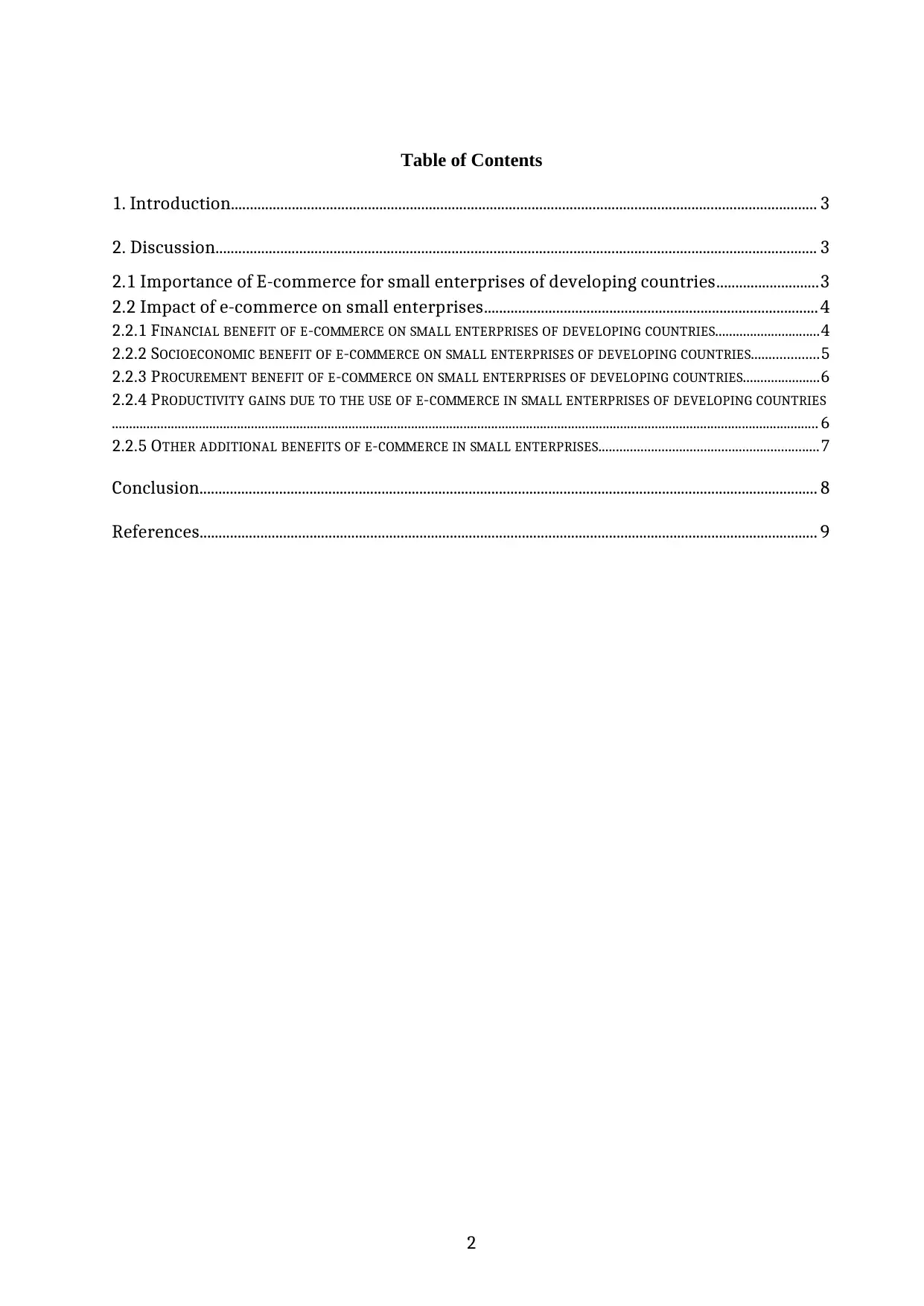
Table of Contents
1. Introduction.......................................................................................................................................................... 3
2. Discussion.............................................................................................................................................................. 3
2.1 Importance of E-commerce for small enterprises of developing countries...........................3
2.2 Impact of e-commerce on small enterprises........................................................................................4
2.2.1 FINANCIAL BENEFIT OF E-COMMERCE ON SMALL ENTERPRISES OF DEVELOPING COUNTRIES..............................4
2.2.2 SOCIOECONOMIC BENEFIT OF E-COMMERCE ON SMALL ENTERPRISES OF DEVELOPING COUNTRIES...................5
2.2.3 PROCUREMENT BENEFIT OF E-COMMERCE ON SMALL ENTERPRISES OF DEVELOPING COUNTRIES......................6
2.2.4 PRODUCTIVITY GAINS DUE TO THE USE OF E-COMMERCE IN SMALL ENTERPRISES OF DEVELOPING COUNTRIES
........................................................................................................................................................................................................... 6
2.2.5 OTHER ADDITIONAL BENEFITS OF E-COMMERCE IN SMALL ENTERPRISES...............................................................7
Conclusion................................................................................................................................................................... 8
References................................................................................................................................................................... 9
2
1. Introduction.......................................................................................................................................................... 3
2. Discussion.............................................................................................................................................................. 3
2.1 Importance of E-commerce for small enterprises of developing countries...........................3
2.2 Impact of e-commerce on small enterprises........................................................................................4
2.2.1 FINANCIAL BENEFIT OF E-COMMERCE ON SMALL ENTERPRISES OF DEVELOPING COUNTRIES..............................4
2.2.2 SOCIOECONOMIC BENEFIT OF E-COMMERCE ON SMALL ENTERPRISES OF DEVELOPING COUNTRIES...................5
2.2.3 PROCUREMENT BENEFIT OF E-COMMERCE ON SMALL ENTERPRISES OF DEVELOPING COUNTRIES......................6
2.2.4 PRODUCTIVITY GAINS DUE TO THE USE OF E-COMMERCE IN SMALL ENTERPRISES OF DEVELOPING COUNTRIES
........................................................................................................................................................................................................... 6
2.2.5 OTHER ADDITIONAL BENEFITS OF E-COMMERCE IN SMALL ENTERPRISES...............................................................7
Conclusion................................................................................................................................................................... 8
References................................................................................................................................................................... 9
2
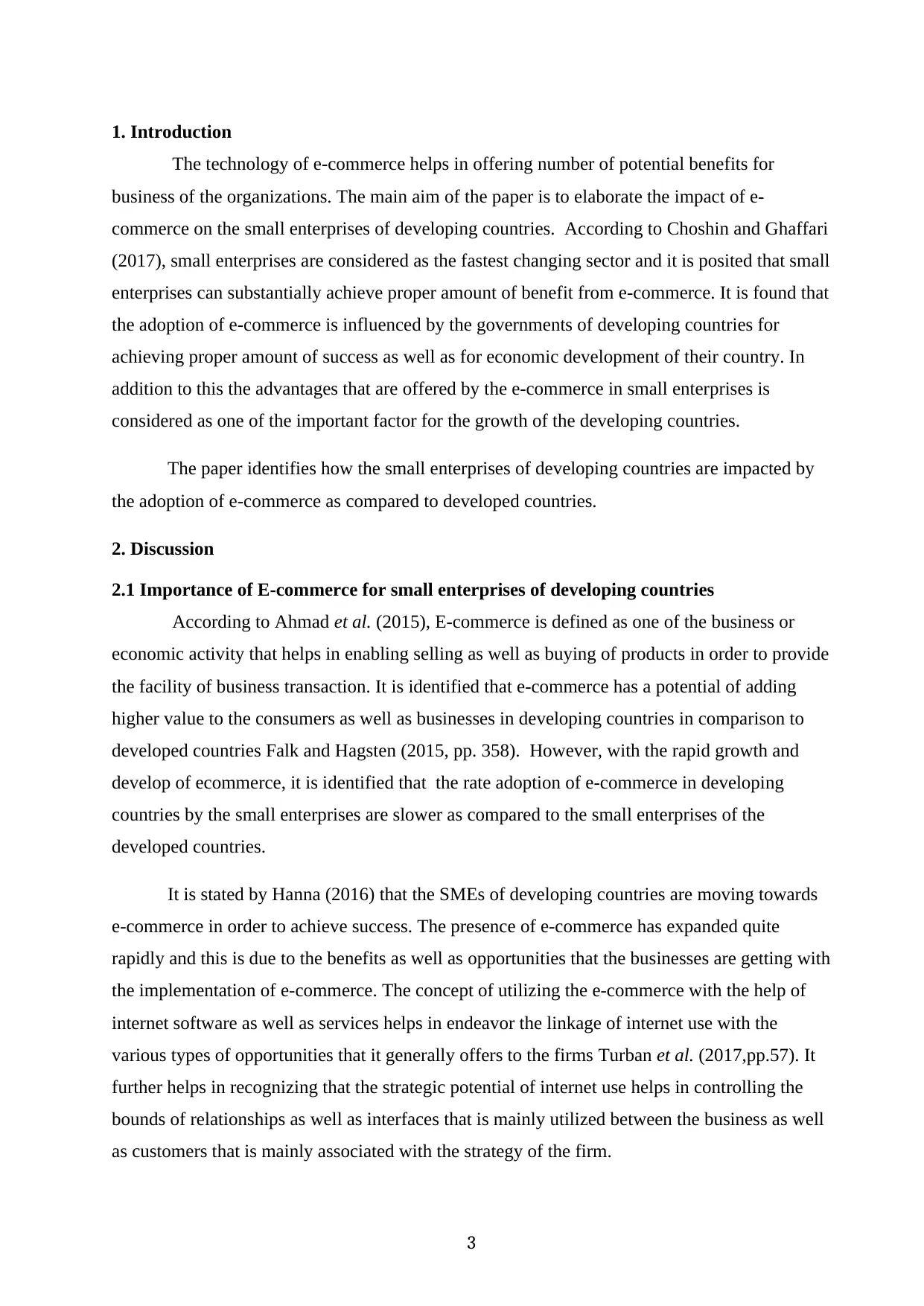
1. Introduction
The technology of e-commerce helps in offering number of potential benefits for
business of the organizations. The main aim of the paper is to elaborate the impact of e-
commerce on the small enterprises of developing countries. According to Choshin and Ghaffari
(2017), small enterprises are considered as the fastest changing sector and it is posited that small
enterprises can substantially achieve proper amount of benefit from e-commerce. It is found that
the adoption of e-commerce is influenced by the governments of developing countries for
achieving proper amount of success as well as for economic development of their country. In
addition to this the advantages that are offered by the e-commerce in small enterprises is
considered as one of the important factor for the growth of the developing countries.
The paper identifies how the small enterprises of developing countries are impacted by
the adoption of e-commerce as compared to developed countries.
2. Discussion
2.1 Importance of E-commerce for small enterprises of developing countries
According to Ahmad et al. (2015), E-commerce is defined as one of the business or
economic activity that helps in enabling selling as well as buying of products in order to provide
the facility of business transaction. It is identified that e-commerce has a potential of adding
higher value to the consumers as well as businesses in developing countries in comparison to
developed countries Falk and Hagsten (2015, pp. 358). However, with the rapid growth and
develop of ecommerce, it is identified that the rate adoption of e-commerce in developing
countries by the small enterprises are slower as compared to the small enterprises of the
developed countries.
It is stated by Hanna (2016) that the SMEs of developing countries are moving towards
e-commerce in order to achieve success. The presence of e-commerce has expanded quite
rapidly and this is due to the benefits as well as opportunities that the businesses are getting with
the implementation of e-commerce. The concept of utilizing the e-commerce with the help of
internet software as well as services helps in endeavor the linkage of internet use with the
various types of opportunities that it generally offers to the firms Turban et al. (2017,pp.57). It
further helps in recognizing that the strategic potential of internet use helps in controlling the
bounds of relationships as well as interfaces that is mainly utilized between the business as well
as customers that is mainly associated with the strategy of the firm.
3
The technology of e-commerce helps in offering number of potential benefits for
business of the organizations. The main aim of the paper is to elaborate the impact of e-
commerce on the small enterprises of developing countries. According to Choshin and Ghaffari
(2017), small enterprises are considered as the fastest changing sector and it is posited that small
enterprises can substantially achieve proper amount of benefit from e-commerce. It is found that
the adoption of e-commerce is influenced by the governments of developing countries for
achieving proper amount of success as well as for economic development of their country. In
addition to this the advantages that are offered by the e-commerce in small enterprises is
considered as one of the important factor for the growth of the developing countries.
The paper identifies how the small enterprises of developing countries are impacted by
the adoption of e-commerce as compared to developed countries.
2. Discussion
2.1 Importance of E-commerce for small enterprises of developing countries
According to Ahmad et al. (2015), E-commerce is defined as one of the business or
economic activity that helps in enabling selling as well as buying of products in order to provide
the facility of business transaction. It is identified that e-commerce has a potential of adding
higher value to the consumers as well as businesses in developing countries in comparison to
developed countries Falk and Hagsten (2015, pp. 358). However, with the rapid growth and
develop of ecommerce, it is identified that the rate adoption of e-commerce in developing
countries by the small enterprises are slower as compared to the small enterprises of the
developed countries.
It is stated by Hanna (2016) that the SMEs of developing countries are moving towards
e-commerce in order to achieve success. The presence of e-commerce has expanded quite
rapidly and this is due to the benefits as well as opportunities that the businesses are getting with
the implementation of e-commerce. The concept of utilizing the e-commerce with the help of
internet software as well as services helps in endeavor the linkage of internet use with the
various types of opportunities that it generally offers to the firms Turban et al. (2017,pp.57). It
further helps in recognizing that the strategic potential of internet use helps in controlling the
bounds of relationships as well as interfaces that is mainly utilized between the business as well
as customers that is mainly associated with the strategy of the firm.
3
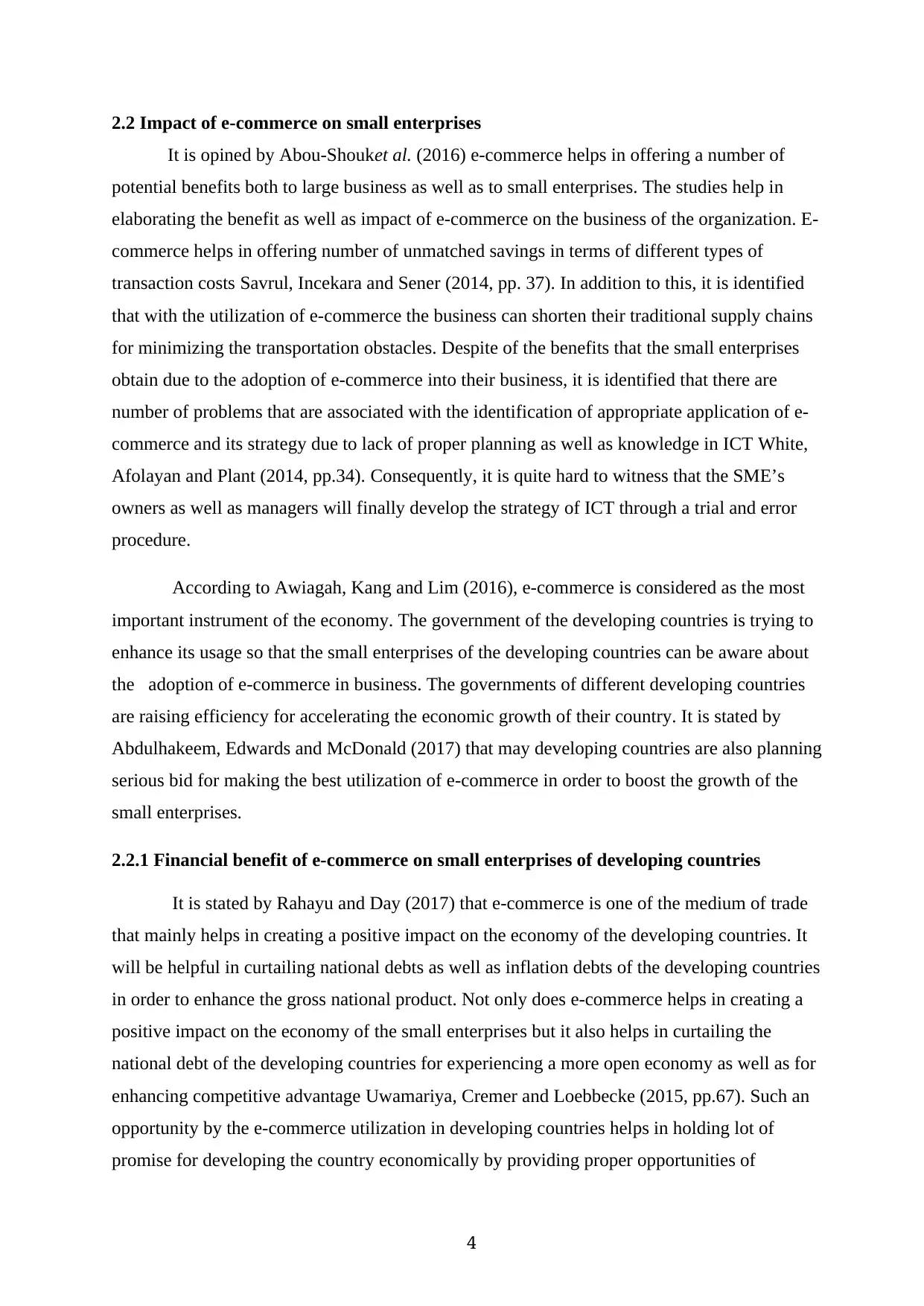
2.2 Impact of e-commerce on small enterprises
It is opined by Abou-Shouket al. (2016) e-commerce helps in offering a number of
potential benefits both to large business as well as to small enterprises. The studies help in
elaborating the benefit as well as impact of e-commerce on the business of the organization. E-
commerce helps in offering number of unmatched savings in terms of different types of
transaction costs Savrul, Incekara and Sener (2014, pp. 37). In addition to this, it is identified
that with the utilization of e-commerce the business can shorten their traditional supply chains
for minimizing the transportation obstacles. Despite of the benefits that the small enterprises
obtain due to the adoption of e-commerce into their business, it is identified that there are
number of problems that are associated with the identification of appropriate application of e-
commerce and its strategy due to lack of proper planning as well as knowledge in ICT White,
Afolayan and Plant (2014, pp.34). Consequently, it is quite hard to witness that the SME’s
owners as well as managers will finally develop the strategy of ICT through a trial and error
procedure.
According to Awiagah, Kang and Lim (2016), e-commerce is considered as the most
important instrument of the economy. The government of the developing countries is trying to
enhance its usage so that the small enterprises of the developing countries can be aware about
the adoption of e-commerce in business. The governments of different developing countries
are raising efficiency for accelerating the economic growth of their country. It is stated by
Abdulhakeem, Edwards and McDonald (2017) that may developing countries are also planning
serious bid for making the best utilization of e-commerce in order to boost the growth of the
small enterprises.
2.2.1 Financial benefit of e-commerce on small enterprises of developing countries
It is stated by Rahayu and Day (2017) that e-commerce is one of the medium of trade
that mainly helps in creating a positive impact on the economy of the developing countries. It
will be helpful in curtailing national debts as well as inflation debts of the developing countries
in order to enhance the gross national product. Not only does e-commerce helps in creating a
positive impact on the economy of the small enterprises but it also helps in curtailing the
national debt of the developing countries for experiencing a more open economy as well as for
enhancing competitive advantage Uwamariya, Cremer and Loebbecke (2015, pp.67). Such an
opportunity by the e-commerce utilization in developing countries helps in holding lot of
promise for developing the country economically by providing proper opportunities of
4
It is opined by Abou-Shouket al. (2016) e-commerce helps in offering a number of
potential benefits both to large business as well as to small enterprises. The studies help in
elaborating the benefit as well as impact of e-commerce on the business of the organization. E-
commerce helps in offering number of unmatched savings in terms of different types of
transaction costs Savrul, Incekara and Sener (2014, pp. 37). In addition to this, it is identified
that with the utilization of e-commerce the business can shorten their traditional supply chains
for minimizing the transportation obstacles. Despite of the benefits that the small enterprises
obtain due to the adoption of e-commerce into their business, it is identified that there are
number of problems that are associated with the identification of appropriate application of e-
commerce and its strategy due to lack of proper planning as well as knowledge in ICT White,
Afolayan and Plant (2014, pp.34). Consequently, it is quite hard to witness that the SME’s
owners as well as managers will finally develop the strategy of ICT through a trial and error
procedure.
According to Awiagah, Kang and Lim (2016), e-commerce is considered as the most
important instrument of the economy. The government of the developing countries is trying to
enhance its usage so that the small enterprises of the developing countries can be aware about
the adoption of e-commerce in business. The governments of different developing countries
are raising efficiency for accelerating the economic growth of their country. It is stated by
Abdulhakeem, Edwards and McDonald (2017) that may developing countries are also planning
serious bid for making the best utilization of e-commerce in order to boost the growth of the
small enterprises.
2.2.1 Financial benefit of e-commerce on small enterprises of developing countries
It is stated by Rahayu and Day (2017) that e-commerce is one of the medium of trade
that mainly helps in creating a positive impact on the economy of the developing countries. It
will be helpful in curtailing national debts as well as inflation debts of the developing countries
in order to enhance the gross national product. Not only does e-commerce helps in creating a
positive impact on the economy of the small enterprises but it also helps in curtailing the
national debt of the developing countries for experiencing a more open economy as well as for
enhancing competitive advantage Uwamariya, Cremer and Loebbecke (2015, pp.67). Such an
opportunity by the e-commerce utilization in developing countries helps in holding lot of
promise for developing the country economically by providing proper opportunities of
4
Secure Best Marks with AI Grader
Need help grading? Try our AI Grader for instant feedback on your assignments.
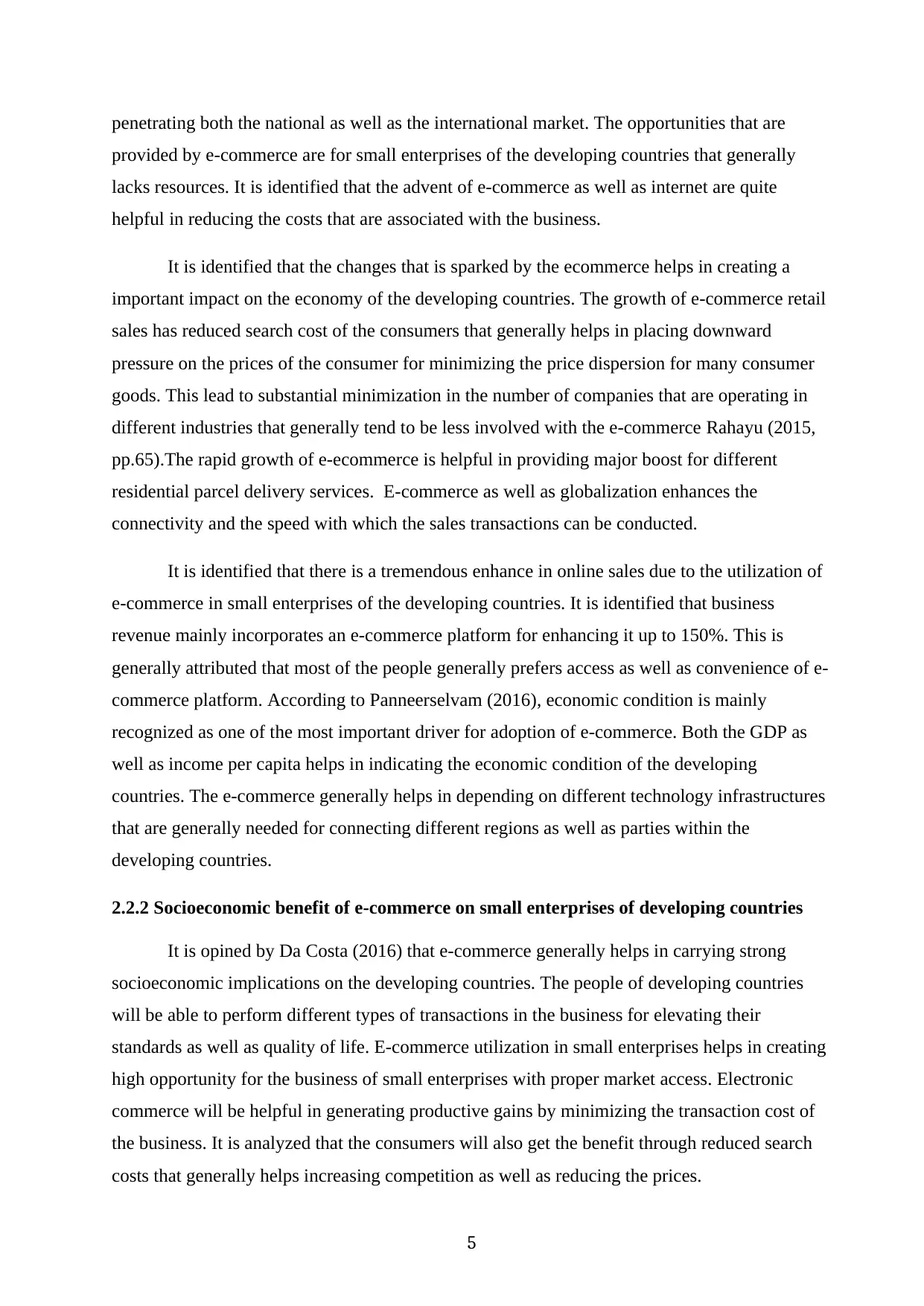
penetrating both the national as well as the international market. The opportunities that are
provided by e-commerce are for small enterprises of the developing countries that generally
lacks resources. It is identified that the advent of e-commerce as well as internet are quite
helpful in reducing the costs that are associated with the business.
It is identified that the changes that is sparked by the ecommerce helps in creating a
important impact on the economy of the developing countries. The growth of e-commerce retail
sales has reduced search cost of the consumers that generally helps in placing downward
pressure on the prices of the consumer for minimizing the price dispersion for many consumer
goods. This lead to substantial minimization in the number of companies that are operating in
different industries that generally tend to be less involved with the e-commerce Rahayu (2015,
pp.65).The rapid growth of e-ecommerce is helpful in providing major boost for different
residential parcel delivery services. E-commerce as well as globalization enhances the
connectivity and the speed with which the sales transactions can be conducted.
It is identified that there is a tremendous enhance in online sales due to the utilization of
e-commerce in small enterprises of the developing countries. It is identified that business
revenue mainly incorporates an e-commerce platform for enhancing it up to 150%. This is
generally attributed that most of the people generally prefers access as well as convenience of e-
commerce platform. According to Panneerselvam (2016), economic condition is mainly
recognized as one of the most important driver for adoption of e-commerce. Both the GDP as
well as income per capita helps in indicating the economic condition of the developing
countries. The e-commerce generally helps in depending on different technology infrastructures
that are generally needed for connecting different regions as well as parties within the
developing countries.
2.2.2 Socioeconomic benefit of e-commerce on small enterprises of developing countries
It is opined by Da Costa (2016) that e-commerce generally helps in carrying strong
socioeconomic implications on the developing countries. The people of developing countries
will be able to perform different types of transactions in the business for elevating their
standards as well as quality of life. E-commerce utilization in small enterprises helps in creating
high opportunity for the business of small enterprises with proper market access. Electronic
commerce will be helpful in generating productive gains by minimizing the transaction cost of
the business. It is analyzed that the consumers will also get the benefit through reduced search
costs that generally helps increasing competition as well as reducing the prices.
5
provided by e-commerce are for small enterprises of the developing countries that generally
lacks resources. It is identified that the advent of e-commerce as well as internet are quite
helpful in reducing the costs that are associated with the business.
It is identified that the changes that is sparked by the ecommerce helps in creating a
important impact on the economy of the developing countries. The growth of e-commerce retail
sales has reduced search cost of the consumers that generally helps in placing downward
pressure on the prices of the consumer for minimizing the price dispersion for many consumer
goods. This lead to substantial minimization in the number of companies that are operating in
different industries that generally tend to be less involved with the e-commerce Rahayu (2015,
pp.65).The rapid growth of e-ecommerce is helpful in providing major boost for different
residential parcel delivery services. E-commerce as well as globalization enhances the
connectivity and the speed with which the sales transactions can be conducted.
It is identified that there is a tremendous enhance in online sales due to the utilization of
e-commerce in small enterprises of the developing countries. It is identified that business
revenue mainly incorporates an e-commerce platform for enhancing it up to 150%. This is
generally attributed that most of the people generally prefers access as well as convenience of e-
commerce platform. According to Panneerselvam (2016), economic condition is mainly
recognized as one of the most important driver for adoption of e-commerce. Both the GDP as
well as income per capita helps in indicating the economic condition of the developing
countries. The e-commerce generally helps in depending on different technology infrastructures
that are generally needed for connecting different regions as well as parties within the
developing countries.
2.2.2 Socioeconomic benefit of e-commerce on small enterprises of developing countries
It is opined by Da Costa (2016) that e-commerce generally helps in carrying strong
socioeconomic implications on the developing countries. The people of developing countries
will be able to perform different types of transactions in the business for elevating their
standards as well as quality of life. E-commerce utilization in small enterprises helps in creating
high opportunity for the business of small enterprises with proper market access. Electronic
commerce will be helpful in generating productive gains by minimizing the transaction cost of
the business. It is analyzed that the consumers will also get the benefit through reduced search
costs that generally helps increasing competition as well as reducing the prices.
5
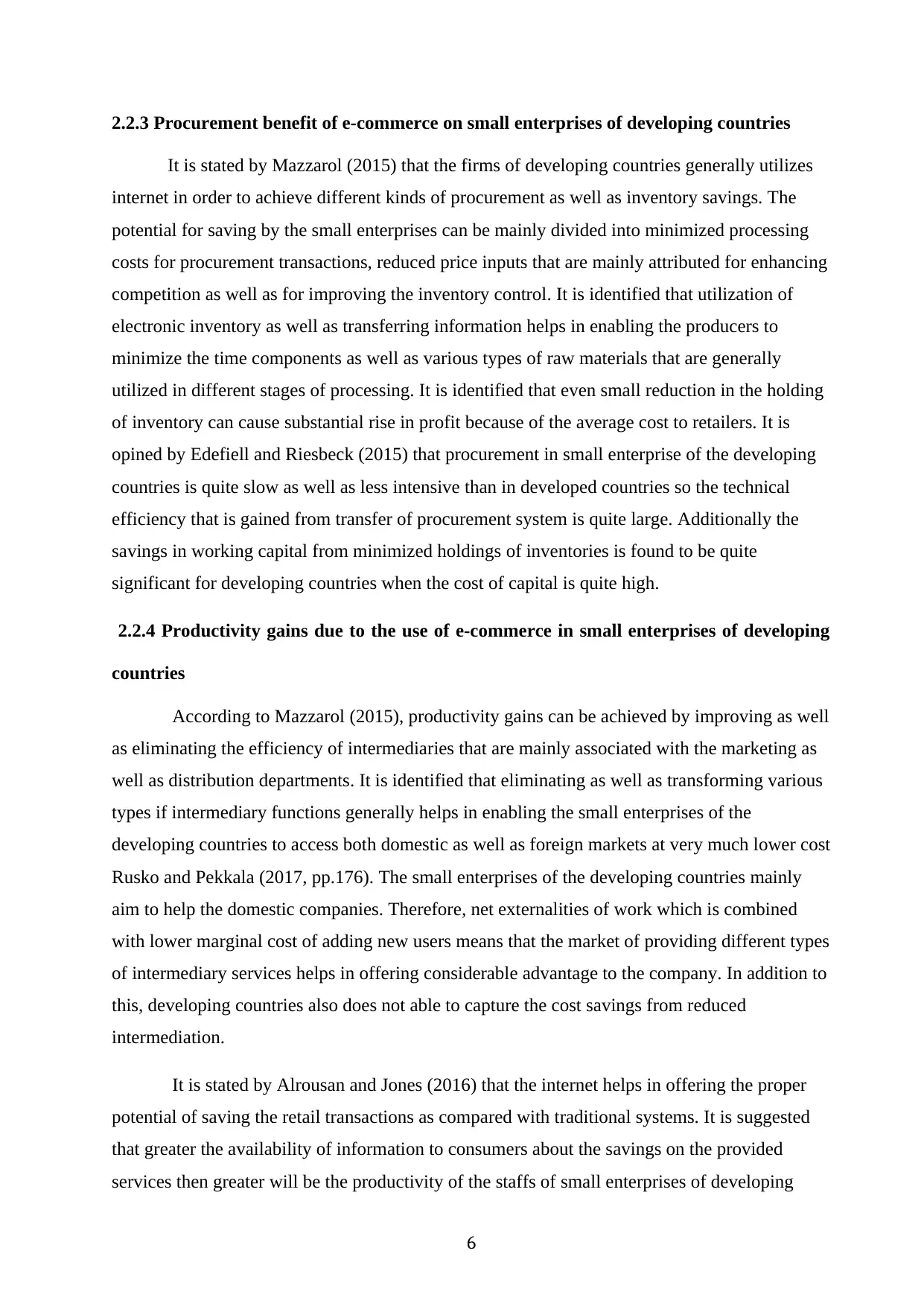
2.2.3 Procurement benefit of e-commerce on small enterprises of developing countries
It is stated by Mazzarol (2015) that the firms of developing countries generally utilizes
internet in order to achieve different kinds of procurement as well as inventory savings. The
potential for saving by the small enterprises can be mainly divided into minimized processing
costs for procurement transactions, reduced price inputs that are mainly attributed for enhancing
competition as well as for improving the inventory control. It is identified that utilization of
electronic inventory as well as transferring information helps in enabling the producers to
minimize the time components as well as various types of raw materials that are generally
utilized in different stages of processing. It is identified that even small reduction in the holding
of inventory can cause substantial rise in profit because of the average cost to retailers. It is
opined by Edefiell and Riesbeck (2015) that procurement in small enterprise of the developing
countries is quite slow as well as less intensive than in developed countries so the technical
efficiency that is gained from transfer of procurement system is quite large. Additionally the
savings in working capital from minimized holdings of inventories is found to be quite
significant for developing countries when the cost of capital is quite high.
2.2.4 Productivity gains due to the use of e-commerce in small enterprises of developing
countries
According to Mazzarol (2015), productivity gains can be achieved by improving as well
as eliminating the efficiency of intermediaries that are mainly associated with the marketing as
well as distribution departments. It is identified that eliminating as well as transforming various
types if intermediary functions generally helps in enabling the small enterprises of the
developing countries to access both domestic as well as foreign markets at very much lower cost
Rusko and Pekkala (2017, pp.176). The small enterprises of the developing countries mainly
aim to help the domestic companies. Therefore, net externalities of work which is combined
with lower marginal cost of adding new users means that the market of providing different types
of intermediary services helps in offering considerable advantage to the company. In addition to
this, developing countries also does not able to capture the cost savings from reduced
intermediation.
It is stated by Alrousan and Jones (2016) that the internet helps in offering the proper
potential of saving the retail transactions as compared with traditional systems. It is suggested
that greater the availability of information to consumers about the savings on the provided
services then greater will be the productivity of the staffs of small enterprises of developing
6
It is stated by Mazzarol (2015) that the firms of developing countries generally utilizes
internet in order to achieve different kinds of procurement as well as inventory savings. The
potential for saving by the small enterprises can be mainly divided into minimized processing
costs for procurement transactions, reduced price inputs that are mainly attributed for enhancing
competition as well as for improving the inventory control. It is identified that utilization of
electronic inventory as well as transferring information helps in enabling the producers to
minimize the time components as well as various types of raw materials that are generally
utilized in different stages of processing. It is identified that even small reduction in the holding
of inventory can cause substantial rise in profit because of the average cost to retailers. It is
opined by Edefiell and Riesbeck (2015) that procurement in small enterprise of the developing
countries is quite slow as well as less intensive than in developed countries so the technical
efficiency that is gained from transfer of procurement system is quite large. Additionally the
savings in working capital from minimized holdings of inventories is found to be quite
significant for developing countries when the cost of capital is quite high.
2.2.4 Productivity gains due to the use of e-commerce in small enterprises of developing
countries
According to Mazzarol (2015), productivity gains can be achieved by improving as well
as eliminating the efficiency of intermediaries that are mainly associated with the marketing as
well as distribution departments. It is identified that eliminating as well as transforming various
types if intermediary functions generally helps in enabling the small enterprises of the
developing countries to access both domestic as well as foreign markets at very much lower cost
Rusko and Pekkala (2017, pp.176). The small enterprises of the developing countries mainly
aim to help the domestic companies. Therefore, net externalities of work which is combined
with lower marginal cost of adding new users means that the market of providing different types
of intermediary services helps in offering considerable advantage to the company. In addition to
this, developing countries also does not able to capture the cost savings from reduced
intermediation.
It is stated by Alrousan and Jones (2016) that the internet helps in offering the proper
potential of saving the retail transactions as compared with traditional systems. It is suggested
that greater the availability of information to consumers about the savings on the provided
services then greater will be the productivity of the staffs of small enterprises of developing
6
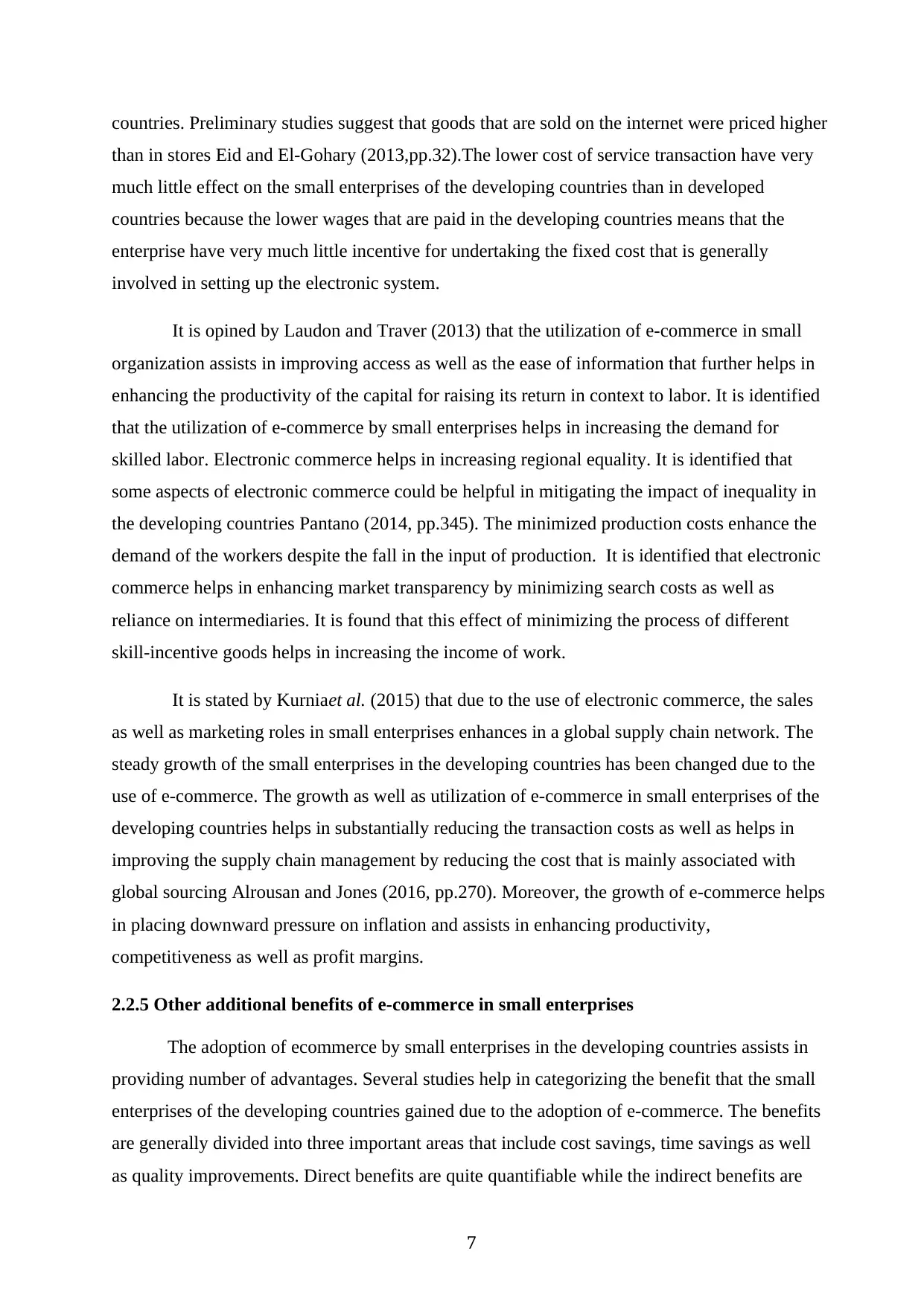
countries. Preliminary studies suggest that goods that are sold on the internet were priced higher
than in stores Eid and El-Gohary (2013,pp.32).The lower cost of service transaction have very
much little effect on the small enterprises of the developing countries than in developed
countries because the lower wages that are paid in the developing countries means that the
enterprise have very much little incentive for undertaking the fixed cost that is generally
involved in setting up the electronic system.
It is opined by Laudon and Traver (2013) that the utilization of e-commerce in small
organization assists in improving access as well as the ease of information that further helps in
enhancing the productivity of the capital for raising its return in context to labor. It is identified
that the utilization of e-commerce by small enterprises helps in increasing the demand for
skilled labor. Electronic commerce helps in increasing regional equality. It is identified that
some aspects of electronic commerce could be helpful in mitigating the impact of inequality in
the developing countries Pantano (2014, pp.345). The minimized production costs enhance the
demand of the workers despite the fall in the input of production. It is identified that electronic
commerce helps in enhancing market transparency by minimizing search costs as well as
reliance on intermediaries. It is found that this effect of minimizing the process of different
skill-incentive goods helps in increasing the income of work.
It is stated by Kurniaet al. (2015) that due to the use of electronic commerce, the sales
as well as marketing roles in small enterprises enhances in a global supply chain network. The
steady growth of the small enterprises in the developing countries has been changed due to the
use of e-commerce. The growth as well as utilization of e-commerce in small enterprises of the
developing countries helps in substantially reducing the transaction costs as well as helps in
improving the supply chain management by reducing the cost that is mainly associated with
global sourcing Alrousan and Jones (2016, pp.270). Moreover, the growth of e-commerce helps
in placing downward pressure on inflation and assists in enhancing productivity,
competitiveness as well as profit margins.
2.2.5 Other additional benefits of e-commerce in small enterprises
The adoption of ecommerce by small enterprises in the developing countries assists in
providing number of advantages. Several studies help in categorizing the benefit that the small
enterprises of the developing countries gained due to the adoption of e-commerce. The benefits
are generally divided into three important areas that include cost savings, time savings as well
as quality improvements. Direct benefits are quite quantifiable while the indirect benefits are
7
than in stores Eid and El-Gohary (2013,pp.32).The lower cost of service transaction have very
much little effect on the small enterprises of the developing countries than in developed
countries because the lower wages that are paid in the developing countries means that the
enterprise have very much little incentive for undertaking the fixed cost that is generally
involved in setting up the electronic system.
It is opined by Laudon and Traver (2013) that the utilization of e-commerce in small
organization assists in improving access as well as the ease of information that further helps in
enhancing the productivity of the capital for raising its return in context to labor. It is identified
that the utilization of e-commerce by small enterprises helps in increasing the demand for
skilled labor. Electronic commerce helps in increasing regional equality. It is identified that
some aspects of electronic commerce could be helpful in mitigating the impact of inequality in
the developing countries Pantano (2014, pp.345). The minimized production costs enhance the
demand of the workers despite the fall in the input of production. It is identified that electronic
commerce helps in enhancing market transparency by minimizing search costs as well as
reliance on intermediaries. It is found that this effect of minimizing the process of different
skill-incentive goods helps in increasing the income of work.
It is stated by Kurniaet al. (2015) that due to the use of electronic commerce, the sales
as well as marketing roles in small enterprises enhances in a global supply chain network. The
steady growth of the small enterprises in the developing countries has been changed due to the
use of e-commerce. The growth as well as utilization of e-commerce in small enterprises of the
developing countries helps in substantially reducing the transaction costs as well as helps in
improving the supply chain management by reducing the cost that is mainly associated with
global sourcing Alrousan and Jones (2016, pp.270). Moreover, the growth of e-commerce helps
in placing downward pressure on inflation and assists in enhancing productivity,
competitiveness as well as profit margins.
2.2.5 Other additional benefits of e-commerce in small enterprises
The adoption of ecommerce by small enterprises in the developing countries assists in
providing number of advantages. Several studies help in categorizing the benefit that the small
enterprises of the developing countries gained due to the adoption of e-commerce. The benefits
are generally divided into three important areas that include cost savings, time savings as well
as quality improvements. Direct benefits are quite quantifiable while the indirect benefits are
7
Paraphrase This Document
Need a fresh take? Get an instant paraphrase of this document with our AI Paraphraser
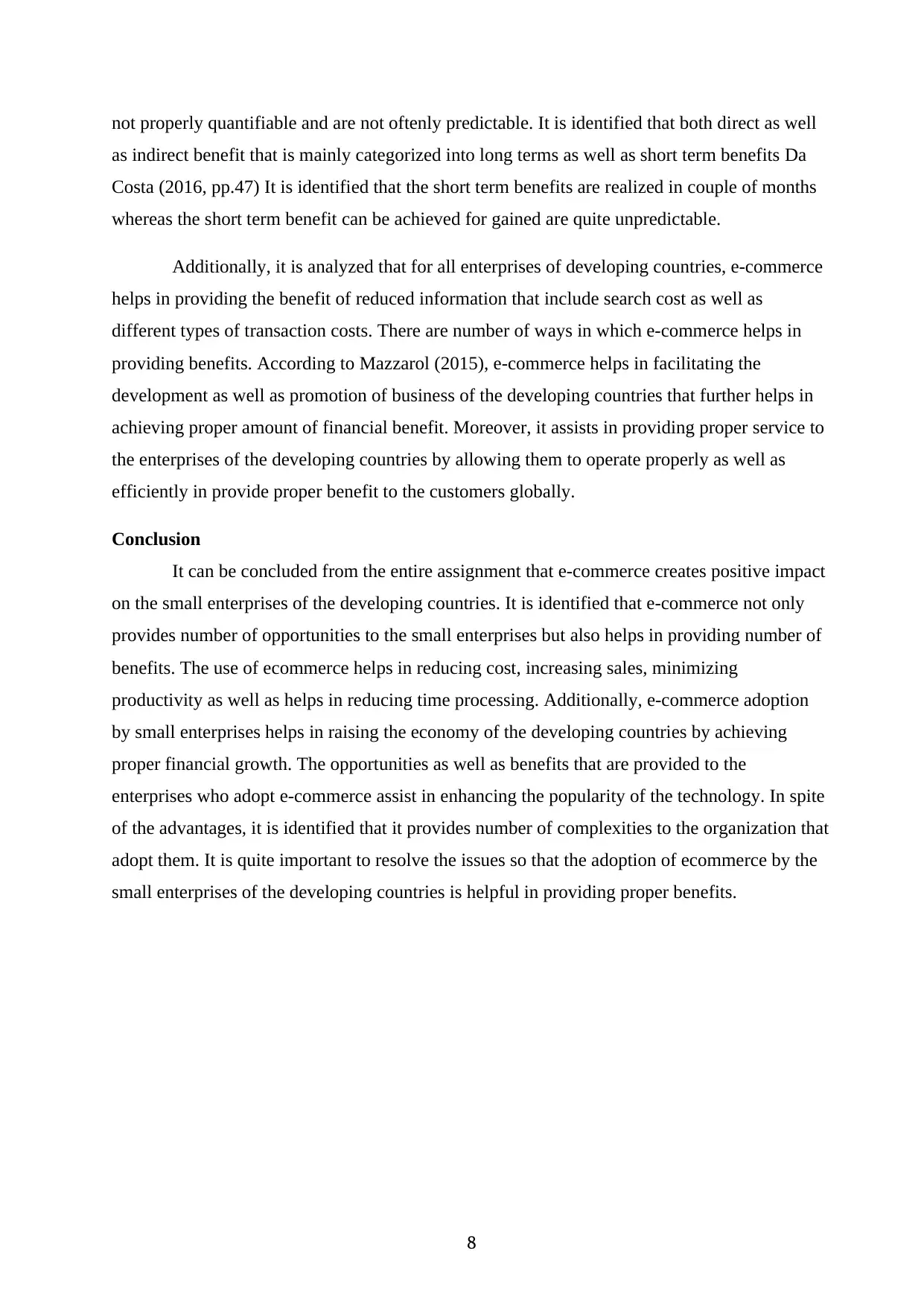
not properly quantifiable and are not oftenly predictable. It is identified that both direct as well
as indirect benefit that is mainly categorized into long terms as well as short term benefits Da
Costa (2016, pp.47) It is identified that the short term benefits are realized in couple of months
whereas the short term benefit can be achieved for gained are quite unpredictable.
Additionally, it is analyzed that for all enterprises of developing countries, e-commerce
helps in providing the benefit of reduced information that include search cost as well as
different types of transaction costs. There are number of ways in which e-commerce helps in
providing benefits. According to Mazzarol (2015), e-commerce helps in facilitating the
development as well as promotion of business of the developing countries that further helps in
achieving proper amount of financial benefit. Moreover, it assists in providing proper service to
the enterprises of the developing countries by allowing them to operate properly as well as
efficiently in provide proper benefit to the customers globally.
Conclusion
It can be concluded from the entire assignment that e-commerce creates positive impact
on the small enterprises of the developing countries. It is identified that e-commerce not only
provides number of opportunities to the small enterprises but also helps in providing number of
benefits. The use of ecommerce helps in reducing cost, increasing sales, minimizing
productivity as well as helps in reducing time processing. Additionally, e-commerce adoption
by small enterprises helps in raising the economy of the developing countries by achieving
proper financial growth. The opportunities as well as benefits that are provided to the
enterprises who adopt e-commerce assist in enhancing the popularity of the technology. In spite
of the advantages, it is identified that it provides number of complexities to the organization that
adopt them. It is quite important to resolve the issues so that the adoption of ecommerce by the
small enterprises of the developing countries is helpful in providing proper benefits.
8
as indirect benefit that is mainly categorized into long terms as well as short term benefits Da
Costa (2016, pp.47) It is identified that the short term benefits are realized in couple of months
whereas the short term benefit can be achieved for gained are quite unpredictable.
Additionally, it is analyzed that for all enterprises of developing countries, e-commerce
helps in providing the benefit of reduced information that include search cost as well as
different types of transaction costs. There are number of ways in which e-commerce helps in
providing benefits. According to Mazzarol (2015), e-commerce helps in facilitating the
development as well as promotion of business of the developing countries that further helps in
achieving proper amount of financial benefit. Moreover, it assists in providing proper service to
the enterprises of the developing countries by allowing them to operate properly as well as
efficiently in provide proper benefit to the customers globally.
Conclusion
It can be concluded from the entire assignment that e-commerce creates positive impact
on the small enterprises of the developing countries. It is identified that e-commerce not only
provides number of opportunities to the small enterprises but also helps in providing number of
benefits. The use of ecommerce helps in reducing cost, increasing sales, minimizing
productivity as well as helps in reducing time processing. Additionally, e-commerce adoption
by small enterprises helps in raising the economy of the developing countries by achieving
proper financial growth. The opportunities as well as benefits that are provided to the
enterprises who adopt e-commerce assist in enhancing the popularity of the technology. In spite
of the advantages, it is identified that it provides number of complexities to the organization that
adopt them. It is quite important to resolve the issues so that the adoption of ecommerce by the
small enterprises of the developing countries is helpful in providing proper benefits.
8
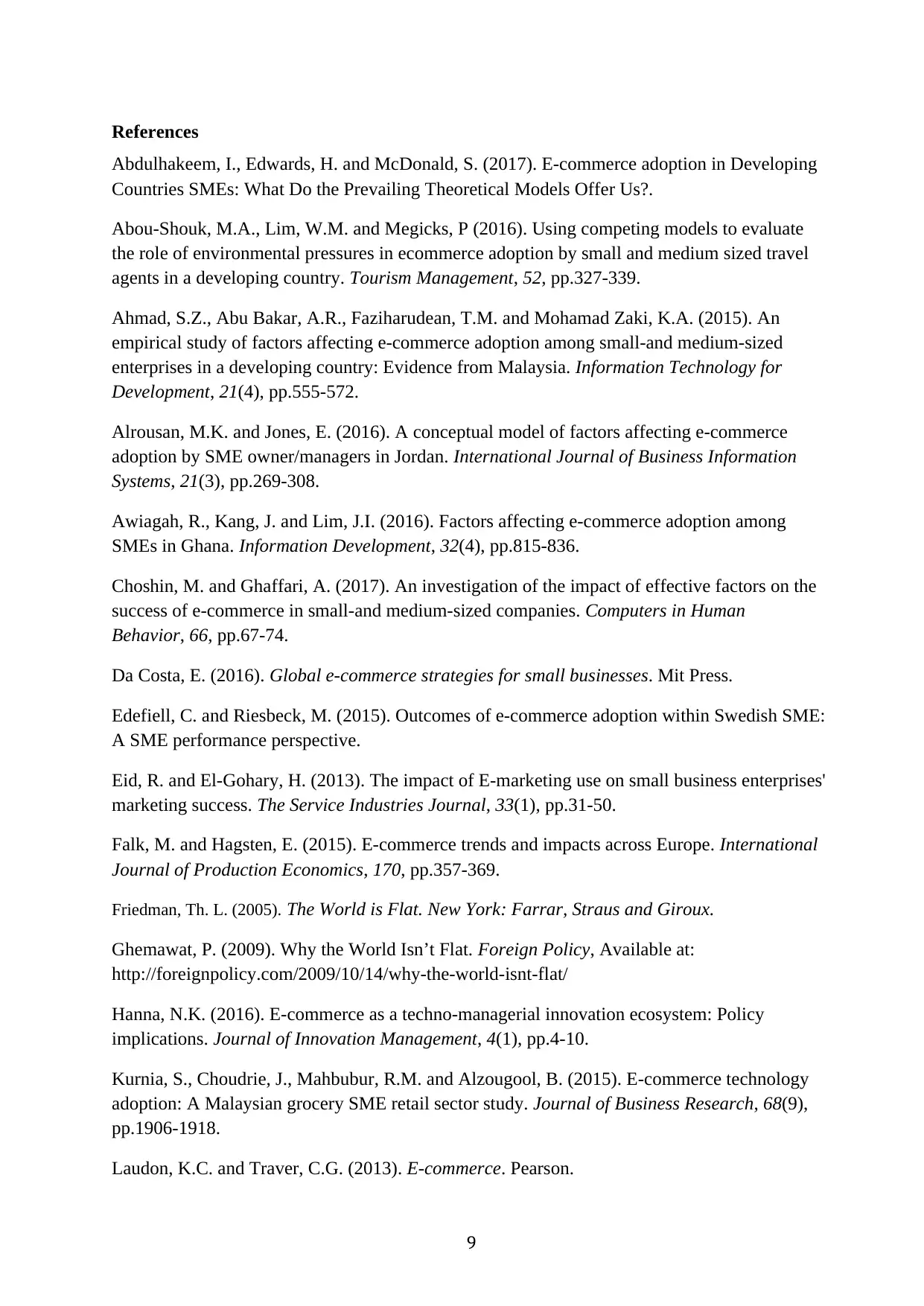
References
Abdulhakeem, I., Edwards, H. and McDonald, S. (2017). E-commerce adoption in Developing
Countries SMEs: What Do the Prevailing Theoretical Models Offer Us?.
Abou-Shouk, M.A., Lim, W.M. and Megicks, P (2016). Using competing models to evaluate
the role of environmental pressures in ecommerce adoption by small and medium sized travel
agents in a developing country. Tourism Management, 52, pp.327-339.
Ahmad, S.Z., Abu Bakar, A.R., Faziharudean, T.M. and Mohamad Zaki, K.A. (2015). An
empirical study of factors affecting e-commerce adoption among small-and medium-sized
enterprises in a developing country: Evidence from Malaysia. Information Technology for
Development, 21(4), pp.555-572.
Alrousan, M.K. and Jones, E. (2016). A conceptual model of factors affecting e-commerce
adoption by SME owner/managers in Jordan. International Journal of Business Information
Systems, 21(3), pp.269-308.
Awiagah, R., Kang, J. and Lim, J.I. (2016). Factors affecting e-commerce adoption among
SMEs in Ghana. Information Development, 32(4), pp.815-836.
Choshin, M. and Ghaffari, A. (2017). An investigation of the impact of effective factors on the
success of e-commerce in small-and medium-sized companies. Computers in Human
Behavior, 66, pp.67-74.
Da Costa, E. (2016). Global e-commerce strategies for small businesses. Mit Press.
Edefiell, C. and Riesbeck, M. (2015). Outcomes of e-commerce adoption within Swedish SME:
A SME performance perspective.
Eid, R. and El-Gohary, H. (2013). The impact of E-marketing use on small business enterprises'
marketing success. The Service Industries Journal, 33(1), pp.31-50.
Falk, M. and Hagsten, E. (2015). E-commerce trends and impacts across Europe. International
Journal of Production Economics, 170, pp.357-369.
Friedman, Th. L. (2005). The World is Flat. New York: Farrar, Straus and Giroux.
Ghemawat, P. (2009). Why the World Isn’t Flat. Foreign Policy, Available at:
http://foreignpolicy.com/2009/10/14/why-the-world-isnt-flat/
Hanna, N.K. (2016). E-commerce as a techno-managerial innovation ecosystem: Policy
implications. Journal of Innovation Management, 4(1), pp.4-10.
Kurnia, S., Choudrie, J., Mahbubur, R.M. and Alzougool, B. (2015). E-commerce technology
adoption: A Malaysian grocery SME retail sector study. Journal of Business Research, 68(9),
pp.1906-1918.
Laudon, K.C. and Traver, C.G. (2013). E-commerce. Pearson.
9
Abdulhakeem, I., Edwards, H. and McDonald, S. (2017). E-commerce adoption in Developing
Countries SMEs: What Do the Prevailing Theoretical Models Offer Us?.
Abou-Shouk, M.A., Lim, W.M. and Megicks, P (2016). Using competing models to evaluate
the role of environmental pressures in ecommerce adoption by small and medium sized travel
agents in a developing country. Tourism Management, 52, pp.327-339.
Ahmad, S.Z., Abu Bakar, A.R., Faziharudean, T.M. and Mohamad Zaki, K.A. (2015). An
empirical study of factors affecting e-commerce adoption among small-and medium-sized
enterprises in a developing country: Evidence from Malaysia. Information Technology for
Development, 21(4), pp.555-572.
Alrousan, M.K. and Jones, E. (2016). A conceptual model of factors affecting e-commerce
adoption by SME owner/managers in Jordan. International Journal of Business Information
Systems, 21(3), pp.269-308.
Awiagah, R., Kang, J. and Lim, J.I. (2016). Factors affecting e-commerce adoption among
SMEs in Ghana. Information Development, 32(4), pp.815-836.
Choshin, M. and Ghaffari, A. (2017). An investigation of the impact of effective factors on the
success of e-commerce in small-and medium-sized companies. Computers in Human
Behavior, 66, pp.67-74.
Da Costa, E. (2016). Global e-commerce strategies for small businesses. Mit Press.
Edefiell, C. and Riesbeck, M. (2015). Outcomes of e-commerce adoption within Swedish SME:
A SME performance perspective.
Eid, R. and El-Gohary, H. (2013). The impact of E-marketing use on small business enterprises'
marketing success. The Service Industries Journal, 33(1), pp.31-50.
Falk, M. and Hagsten, E. (2015). E-commerce trends and impacts across Europe. International
Journal of Production Economics, 170, pp.357-369.
Friedman, Th. L. (2005). The World is Flat. New York: Farrar, Straus and Giroux.
Ghemawat, P. (2009). Why the World Isn’t Flat. Foreign Policy, Available at:
http://foreignpolicy.com/2009/10/14/why-the-world-isnt-flat/
Hanna, N.K. (2016). E-commerce as a techno-managerial innovation ecosystem: Policy
implications. Journal of Innovation Management, 4(1), pp.4-10.
Kurnia, S., Choudrie, J., Mahbubur, R.M. and Alzougool, B. (2015). E-commerce technology
adoption: A Malaysian grocery SME retail sector study. Journal of Business Research, 68(9),
pp.1906-1918.
Laudon, K.C. and Traver, C.G. (2013). E-commerce. Pearson.
9
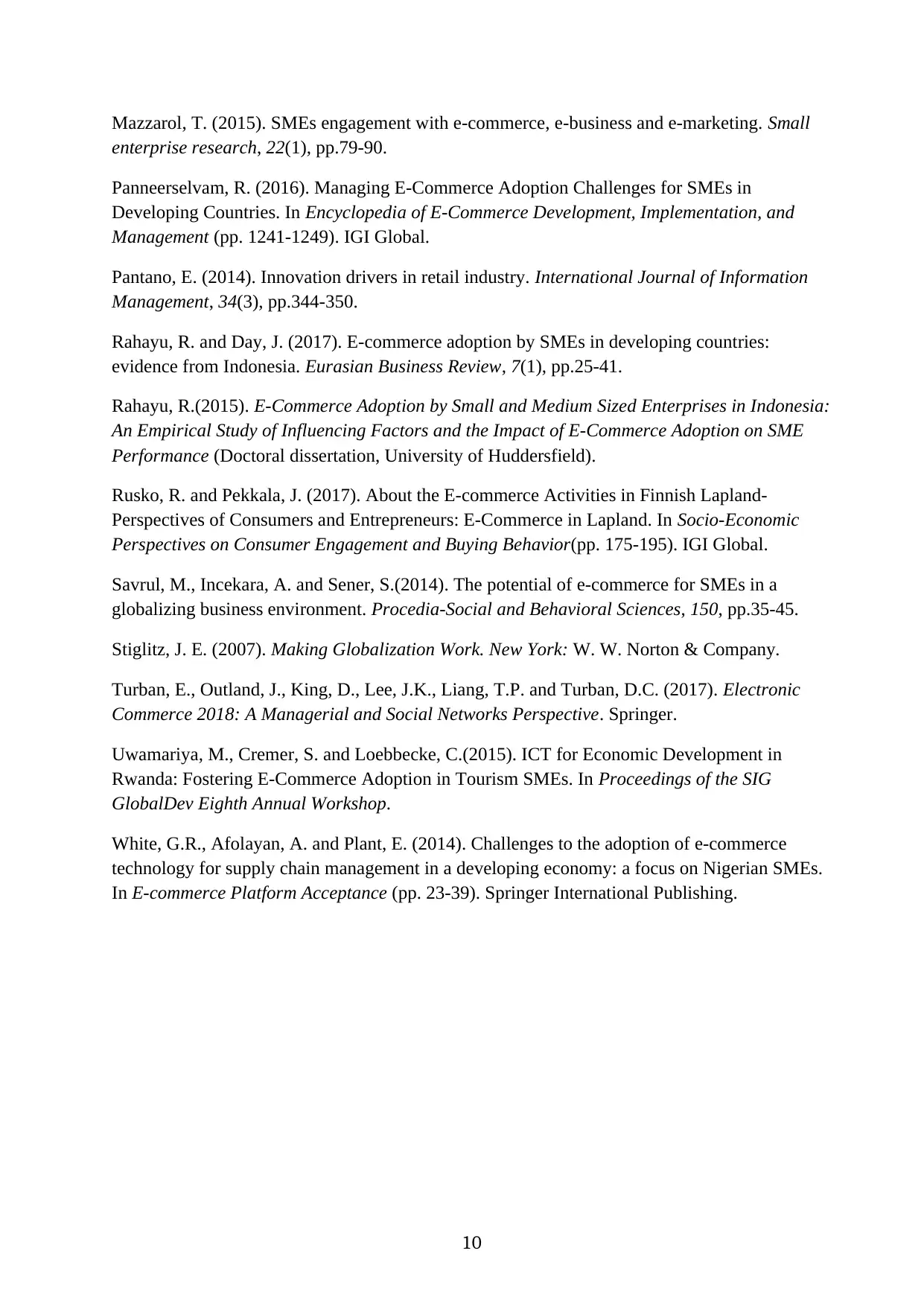
Mazzarol, T. (2015). SMEs engagement with e-commerce, e-business and e-marketing. Small
enterprise research, 22(1), pp.79-90.
Panneerselvam, R. (2016). Managing E-Commerce Adoption Challenges for SMEs in
Developing Countries. In Encyclopedia of E-Commerce Development, Implementation, and
Management (pp. 1241-1249). IGI Global.
Pantano, E. (2014). Innovation drivers in retail industry. International Journal of Information
Management, 34(3), pp.344-350.
Rahayu, R. and Day, J. (2017). E-commerce adoption by SMEs in developing countries:
evidence from Indonesia. Eurasian Business Review, 7(1), pp.25-41.
Rahayu, R.(2015). E-Commerce Adoption by Small and Medium Sized Enterprises in Indonesia:
An Empirical Study of Influencing Factors and the Impact of E-Commerce Adoption on SME
Performance (Doctoral dissertation, University of Huddersfield).
Rusko, R. and Pekkala, J. (2017). About the E-commerce Activities in Finnish Lapland-
Perspectives of Consumers and Entrepreneurs: E-Commerce in Lapland. In Socio-Economic
Perspectives on Consumer Engagement and Buying Behavior(pp. 175-195). IGI Global.
Savrul, M., Incekara, A. and Sener, S.(2014). The potential of e-commerce for SMEs in a
globalizing business environment. Procedia-Social and Behavioral Sciences, 150, pp.35-45.
Stiglitz, J. E. (2007). Making Globalization Work. New York: W. W. Norton & Company.
Turban, E., Outland, J., King, D., Lee, J.K., Liang, T.P. and Turban, D.C. (2017). Electronic
Commerce 2018: A Managerial and Social Networks Perspective. Springer.
Uwamariya, M., Cremer, S. and Loebbecke, C.(2015). ICT for Economic Development in
Rwanda: Fostering E-Commerce Adoption in Tourism SMEs. In Proceedings of the SIG
GlobalDev Eighth Annual Workshop.
White, G.R., Afolayan, A. and Plant, E. (2014). Challenges to the adoption of e-commerce
technology for supply chain management in a developing economy: a focus on Nigerian SMEs.
In E-commerce Platform Acceptance (pp. 23-39). Springer International Publishing.
10
enterprise research, 22(1), pp.79-90.
Panneerselvam, R. (2016). Managing E-Commerce Adoption Challenges for SMEs in
Developing Countries. In Encyclopedia of E-Commerce Development, Implementation, and
Management (pp. 1241-1249). IGI Global.
Pantano, E. (2014). Innovation drivers in retail industry. International Journal of Information
Management, 34(3), pp.344-350.
Rahayu, R. and Day, J. (2017). E-commerce adoption by SMEs in developing countries:
evidence from Indonesia. Eurasian Business Review, 7(1), pp.25-41.
Rahayu, R.(2015). E-Commerce Adoption by Small and Medium Sized Enterprises in Indonesia:
An Empirical Study of Influencing Factors and the Impact of E-Commerce Adoption on SME
Performance (Doctoral dissertation, University of Huddersfield).
Rusko, R. and Pekkala, J. (2017). About the E-commerce Activities in Finnish Lapland-
Perspectives of Consumers and Entrepreneurs: E-Commerce in Lapland. In Socio-Economic
Perspectives on Consumer Engagement and Buying Behavior(pp. 175-195). IGI Global.
Savrul, M., Incekara, A. and Sener, S.(2014). The potential of e-commerce for SMEs in a
globalizing business environment. Procedia-Social and Behavioral Sciences, 150, pp.35-45.
Stiglitz, J. E. (2007). Making Globalization Work. New York: W. W. Norton & Company.
Turban, E., Outland, J., King, D., Lee, J.K., Liang, T.P. and Turban, D.C. (2017). Electronic
Commerce 2018: A Managerial and Social Networks Perspective. Springer.
Uwamariya, M., Cremer, S. and Loebbecke, C.(2015). ICT for Economic Development in
Rwanda: Fostering E-Commerce Adoption in Tourism SMEs. In Proceedings of the SIG
GlobalDev Eighth Annual Workshop.
White, G.R., Afolayan, A. and Plant, E. (2014). Challenges to the adoption of e-commerce
technology for supply chain management in a developing economy: a focus on Nigerian SMEs.
In E-commerce Platform Acceptance (pp. 23-39). Springer International Publishing.
10
1 out of 10
Related Documents
Your All-in-One AI-Powered Toolkit for Academic Success.
+13062052269
info@desklib.com
Available 24*7 on WhatsApp / Email
![[object Object]](/_next/static/media/star-bottom.7253800d.svg)
Unlock your academic potential
© 2024 | Zucol Services PVT LTD | All rights reserved.





